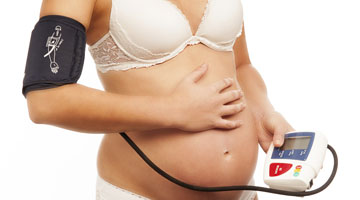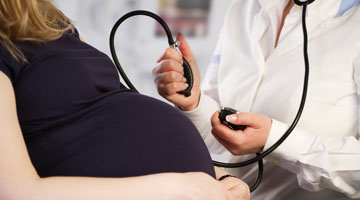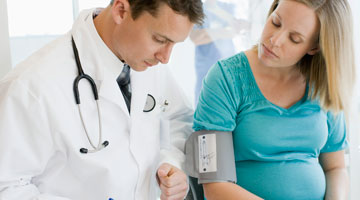Preeclampsia
FAQ about Preeclampsia.
High blood pressure might be an occupational hazard of parenting, but who knew you could be at risk before your child is even born? High blood pressure during pregnancy is known as Preeclampsia, and it is no joke. Kids in the House experts Dr. Shamsah Amersi, MD, OBGYN, and Dr. David Miller, MD, OBGYN, help pregnant mothers and their families learn the warning signs of preeclampsia so that you can get the help you need to have a happy, healthy pregnancy.
What is Preeclampsia?
Preeclampsia, formerly known as toxemia, is a medical condition that affects pregnant women in about 5% of pregnancies. It can be harmful to both mother and baby if left untreated.
Preeclampsia Symptoms, Signs, and Dangers.
There are three major signs of preeclampsia: Hypertension, proteinuria and edema. Hypertension, or high blood pressure, is a blood pressure reading greater than 140/80 measured on two separate occasions, six hours apart. Women with
... Read more
reeclampsia may not have had high blood pressure before becoming pregnant, but for reasons unknown, their blood vessels suddenly constrict, sending blood pressure readings out of normal range. Even if hypertension during pregnancy does not end up being preeclampsia, it is still a serious risk and should be treated by a medical professional right away. When vessels constrict to the brain, it can cause seizures. Vessel constriction to the liver and kidney can cause organ failure, and vessel constriction to the uterus can cause poor weight gain, placental abruption, and a need for emergency delivery of the baby.
Proteinuria is the presence of protein in the urine and is another warning sign of preeclampsia, especially when hypertension is also occurring. Preeclampsia disrupts the filtering capabilities of the kidneys, leaving them unable to block protein from leaving the blood and entering the urine.
Edema, or swelling, is one of the more complicated symptoms of preeclampsia because many women expect this to happen during pregnancy. If the swelling occurs in your face, around your eyes, or in your hands, there may be cause for concern.
Other signs of preeclampsia can include:
- Headache
- Nausea and/or vomiting
- Abdominal and/or shoulder pain
- Lower back pain
- Sudden weight gain
- Changes in vision
- Hyperreflexia
- Shortness of breath
- Anxiety
It is important to note that some women with preeclampsia may not notice any symptoms. You might not be able to tell that your blood pressure has risen, or the symptoms, such as headache or nausea, may seem too ordinary to have checked out by a doctor. Because of this, always ask that your blood pressure and urine be tested and do your best not to miss your pregnancy checkups. Point out any concerns or changes, no matter how slight. If you think you may have swelling in your face or around your eyes, bring a pre-pregnancy photo to your doctor’s appointment for comparison.
Doctors and mothers should keep an eye out for warning signs of preeclampsia during the last trimester. Of the estimated 5% of women who experience preeclampsia, most will see an onset of symptoms right around their due date or 37 week mark. Preeclampsia can present at any time of gestation but usually not until 20 weeks of pregnancy. The earlier preeclampsia occurs, the more severe the case usually is.
There are certain health and genetic characteristics that may predispose women to preeclampsia. Some documented risk factors are:
- Family history of preeclampsia
- Pre-existing hypertension
- Pre-existing chronic kidney disease
- Nulliparity, or never having given birth prior to the current pregnancy
- Insulin-dependent diabetes
- Obesity
The National Institute for Health and Care Excellence recommends that women who are considered moderate to high risk take a low-dose aspirin from time of diagnosis until 36 weeks of pregnancy as a preventative measure.
Preeclampsia Treatment & Prevention
If a preeclampsia diagnosis is made, immediate medical action must be taken. In most cases, the patient’s physician will require her to be admitted to the hospital for testing in order to determine the severity of the preeclampsia.
Diagnoses of severe preeclampsia are based on whether liver and kidney functions are being affected and where the blood pressure reading falls. The only treatment for the preeclampsia condition as a whole is delivery of the baby, but depending on how far along the pregnancy is, an early delivery is not always a safe or feasible option. If an early diagnosis of preeclampsia is made, or if the onset is mild, doctors may try these treatment options to help relieve symptoms and reduce health risks:
- Bed rest
- Magnesium sulfate to lower the risk of seizures
- Blood pressure medications to lower blood pressure to a safer range
- Corticosteroids to help mature the lungs of a fetus younger than 34 weeks, if labor must be induced within 7 days
If the mother is past the 37-week mark, doctors may recommend inducing labor or performing a cesarean section delivery.
While high blood pressure may not always be an emergency in non-pregnant people, hypertension during pregnancy requires rapid treatment and vigilant monitoring. Preeclampsia is a serious medical condition, but one that can be managed by healthcare professionals to lower your risk of complications.










